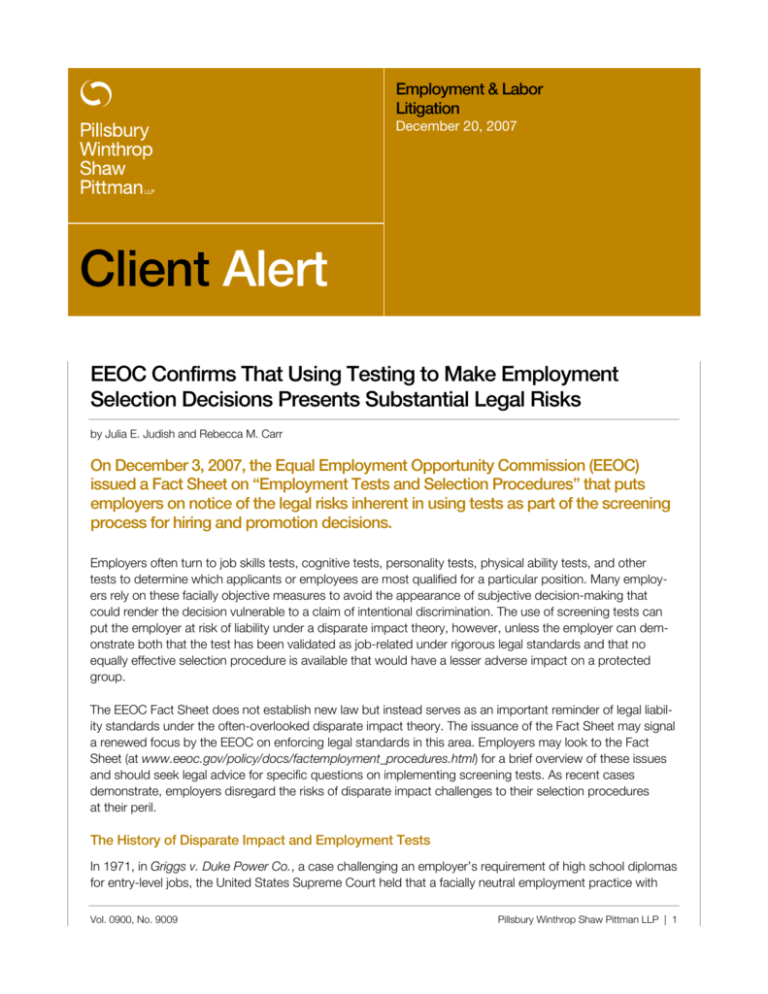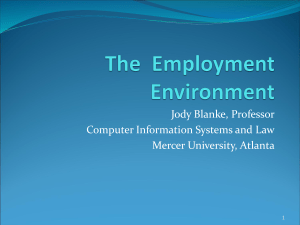
Client Alert
Employment & Labor
Litigation
Employment & Labor
December 20, 2007
Client Alert
EEOC Confirms That Using Testing to Make Employment
Selection Decisions Presents Substantial Legal Risks
by Julia E. Judish and Rebecca M. Carr
On December 3, 2007, the Equal Employment Opportunity Commission (EEOC)
issued a Fact Sheet on “Employment Tests and Selection Procedures” that puts
employers on notice of the legal risks inherent in using tests as part of the screening
process for hiring and promotion decisions.
Employers often turn to job skills tests, cognitive tests, personality tests, physical ability tests, and other
tests to determine which applicants or employees are most qualified for a particular position. Many employers rely on these facially objective measures to avoid the appearance of subjective decision-making that
could render the decision vulnerable to a claim of intentional discrimination. The use of screening tests can
put the employer at risk of liability under a disparate impact theory, however, unless the employer can demonstrate both that the test has been validated as job-related under rigorous legal standards and that no
equally effective selection procedure is available that would have a lesser adverse impact on a protected
group.
The EEOC Fact Sheet does not establish new law but instead serves as an important reminder of legal liability standards under the often-overlooked disparate impact theory. The issuance of the Fact Sheet may signal
a renewed focus by the EEOC on enforcing legal standards in this area. Employers may look to the Fact
Sheet (at www.eeoc.gov/policy/docs/factemployment_procedures.html) for a brief overview of these issues
and should seek legal advice for specific questions on implementing screening tests. As recent cases
demonstrate, employers disregard the risks of disparate impact challenges to their selection procedures
at their peril.
The History of Disparate Impact and Employment Tests
In 1971, in Griggs v. Duke Power Co., a case challenging an employer’s requirement of high school diplomas
for entry-level jobs, the United States Supreme Court held that a facially neutral employment practice with
Vol. 0900, No. 9009
Pillsbury Winthrop Shaw Pittman LLP | 1
Client Alert
Employment & Labor
a disproportionate impact on a racial or other protected group is unlawful under Title VII of the Civil Rights
Act of 1964 if the practice is not “job-related and consistent with business necessity.” In 1975, the Supreme
Court extended the disparate impact theory to employment testing, in Albemarle Paper Co. v. Moody. There,
the Supreme Court held that an employer’s use of the Wonderlic aptitude test to screen candidates into
skilled lines of progression was unlawful because it had an adverse impact on a class of African American
employees and the employer’s “validation study [was] materially defective in several respects.” Although the
employer had made some attempt to validate the test, it had failed to do so with respect to each position in
the line of progression for which the test was used.
In 1978, the EEOC adopted the Uniform Guidelines on Employee Selection Procedures (UGESP), which provides guidelines for employers to determine whether tests and selection procedures are lawful for purposes
of Title VII disparate impact theory. The UGESP outlines three detailed and rigorous methods of test validation on which employers are entitled to rely: criterion-related validity studies, content validity studies, and
construct validity studies. A criterion-related validity study consists of empirical data demonstrating that the
test is predictive of or significantly correlated with important elements of job performance. A content validity
study requires empirical evidence that the content of the test is representative of important aspects of performance on the job for which the candidates are to be evaluated. Alternatively, a construct validity study
uses data to show that the test measures the degree to which candidates have identifiable characteristics
which have been determined to be important in successful performance in the job for which the candidates
are to be evaluated. Although the UGESP allow employers, under certain circumstances, to rely on validity
studies conducted by others, they make clear that the responsibility for test validation rests ultimately with
the employer. The UGESP cautions that empirical evidence is needed for validation and that “under no circumstances will the general reputation of a test or other selection procedures, its author or its publisher,
or casual reports of its validity be accepted in lieu of evidence of validity.”
Recent Examples of Disparate Impact Liability for Testing
As recent cases demonstrate, an employer can find itself liable under the disparate impact theory for using
screening tests without engaging in validation studies, for inadequately attempting to validate a test, or for
ignoring alternatives to a validated test with a lesser adverse impact than the test.
In Isabel v. City of Memphis, for example, the U.S. Court of Appeals for Sixth Circuit affirmed the district
court’s ruling that the Memphis Police Department’s cut-off score on a written test for promoting police sergeants to lieutenants unlawfully discriminated against African-American candidates because the test did not
“approximate a candidate’s potential job performance.” The written test had been developed by a private
consultant and administered by an industrial psychologist. In order to be eligible for lieutenant, a sergeant
had to achieve a passing score of 70. After too few minority candidates passed the test, the industrial psychologist lowered the cut-off score to 66, but the use of the cut-off score had a statistically significant
adverse impact. At trial, the industrial psychologist testified that he had not attempted to validate the cut-off
score and that he was only using a cutoff score because of pressure from the union to do so. Thus, the district court found that the “cutoff score was nothing more than an arbitrary decision and did not measure
minimal qualifications.” The Sixth Circuit affirmed this finding and the district court’s order that the plaintiffs
be promoted and awarded back pay.
In EEOC v. Dial Corp., by contrast, the employer had attempted to validate a pre-employment strength test
that had a disparate impact on female applicants, but the U.S. Court of Appeals for Eighth Circuit nonetheless held that the screening test was unlawful. Dial had implemented several measures to reduce the injury
rate in its Iowa sausage packing area, including instituting a strength test called the Work Tolerance Screen
Vol. 0900, No. 9009
Pillsbury Winthrop Shaw Pittman LLP | 2
Client Alert
Employment & Labor
(WTS) to evaluate job applicants. During the three years prior to the use of the WTS, 46% of new hires were
women, but this number dropped to 15% after the test’s implementation. At trial, to demonstrate content
validity, Dial presented an expert in work physiology who testified that the WTS effectively tested skills that
were representative of the actual job. In addition, an industrial and organizational psychologist testified that
the WTS measured the requirements of the job. To demonstrate criterion validity, the psychologist testified
that the decrease in injuries on the job could be attributed to the test. Further, a plant nurse testified that
while the WTS was screening out more women than men, the WTS was still warranted because of the
decrease in injuries.
The EEOC, however, undercut Dial’s validation evidence by presenting an expert who testified that the WTS
was much more difficult than the actual jobs that the workers performed at the plant and that the injury rate
among female workers had declined prior to the introduction of the WTS with the implementation of other
injury prevention measures. The district court found that the WTS had a discriminatory disparate impact
against women and that Dial had not demonstrated that its use of the WTS was a business necessity or
shown either content or criterion validity. The Eighth Circuit affirmed the district court’s award of back pay
and health benefits to the plaintiffs.
Whereas the prior cases illustrate the importance of stringent test validation studies, even rigorous test validation studies may not protect an employer from liability if a less discriminatory screening method is available. The EEOC filed suit against a major manufacturer on behalf of a nationwide class of African Americans
who were rejected for an apprenticeship program after taking a written cognitive test called the Apprenticeship Training Selection System (ATSS). The ATSS had been validated in 1991; however, it continued to have
a statistically significant disparate impact on African Americans. In addition, less discriminatory selection procedures had since been developed, but the employer did not modify its employment procedures. Although
initially the employer mounted a defense, the company ultimately entered into a settlement agreement that
provided that an industrial organizational psychologist would design and validate an apprenticeship selection
instrument that was consistent with the EEOC guidelines, that the company would select 280 class members for apprentice positions, and the company would pay $8.55 million in relief and about $1.6 million in
attorney’s fees and expenses.
Employment Tests Can Work
Despite these examples of testing done wrong, employment tests done right can play a useful and legal role
in an employer’s selection procedures. For example, Ford Motor Company achieved legal vindication for its
use of a pre-employment test, the Hourly Selection System Test Battery (HSSTB), to screen applicants for
unskilled hourly positions in its Ohio plants.
A class action was brought against Ford alleging that it discriminated against African American employees
through its use of the HSSTB. Based on its validation studies, Ford won a summary judgment that was
affirmed by the Sixth Circuit in Williams v. Ford Motor Co. The Sixth Circuit held that Ford had “sustained its
burden of showing that the HSSTB is manifestly job-related” because Ford had utilized a professional test
developer who conducted a job analysis that complied with the EEOC guidelines in order to create the test
and produced “empirical data that the selection procedure is predictive of or significantly correlated with
important elements of job performance.”
As these cases illustrate, an employer’s decision to include screening tests as part of its selection procedures should not be undertaken lightly, and the use of employment tests must be monitored carefully to
evaluate whether they result in a disproportionate adverse impact on minorities, women, or any legally proVol. 0900, No. 9009
Pillsbury Winthrop Shaw Pittman LLP | 3
Client Alert
Employment & Labor
tected group. Unless a test has been validated as job-related in a manner that meets the demanding federal
guidelines, employers who continue to rely on screening tests despite an adverse impact open themselves to
substantial legal liability.
For further information, please contact:
Julia E. Judish (bio)
Washington, DC
+1.202.663.9266
julia.judish@pillsburylaw.com
Rebecca M. Carr (bio)
Washington, DC
+1.202.663.9143
rebecca.carr@pillsburylaw.com
This publication is issued periodically to keep Pillsbury Winthrop Shaw Pittman LLP clients and other interested parties
informed of current legal developments that may affect or otherwise be of interest to them. The comments contained herein
do not constitute legal opinion and should not be regarded as a substitute for legal advice.
© 2007 Pillsbury Winthrop Shaw Pittman LLP. All Rights Reserved.
Vol. 0900, No. 9009
Pillsbury Winthrop Shaw Pittman LLP | 4







